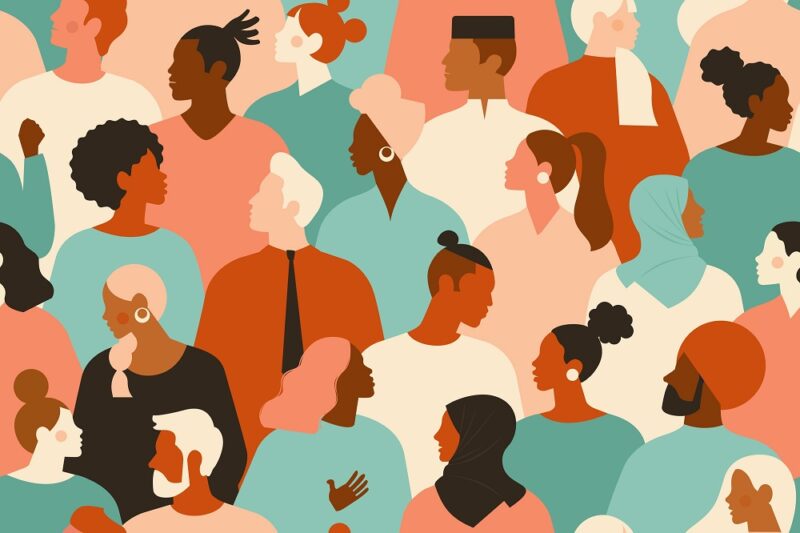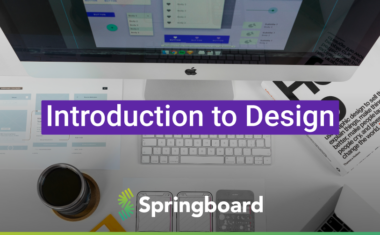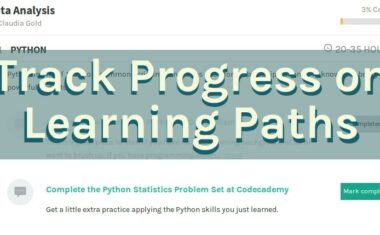Tech Has a Diversity Problem. Here’s What Companies Can Do About It

In this article
When Bria Fauntleroy, a student enrolled in Springboard’s UI/UX Design Career Track, worked as a graphic designer for a pharmaceutical company in Maryland, she was the only Black employee. In every role she’s held since, with the exception of one, she has been the only Black female on staff.
“Most companies say diversity and inclusion are a priority, but then when you look at their employee roster, it doesn’t look that way,” she says. “It’s so great that Springboard actually has the power to change that. I’ve seen a lot of people of color in my career track.”
McKinsey estimates that companies spend $8 billion a year collectively on diversity and inclusion (D&I) training. Yet, the tech workforce remains stubbornly homogenous, even as companies have begun publishing diversity reports and touting their commitment to D&I as a recruitment tooI. In 2021, just 33.1% of the people hired at Google were women.
The numbers for the tech industry as a whole skew even less favorably. Men hold 75% of US tech jobs and receive 3% higher salary offers than women. As we approach a future where an estimated 45 million people will lose their jobs to automation by 2030, improving diversity in the tech industry is no longer just a moral imperative: it’s key to reducing economic inequality. The median income in the US stands at $44,225, while salaries for tech workers averaged above six figures in 2021. What’s more, stock options at tech startups are a major wealth creator, leading to a gaping wealth gap between those working within and outside of the tech industry.
Why is tech’s diversity problem so persistent?
Tech’s diversity problem has been blamed on many things—from gender-discriminating applicant tracking systems and the failings of the K-12 education system, to startup “bro culture” that creates an unwelcoming work environment for anyone who doesn’t identify as a white, cis-gendered, heterosexual male.
According to a survey by mthree, 68% of 18-28 year olds say they have felt uncomfortable in a job because of their gender, ethnicity, socioeconomic background or neurodevelopmental condition. Meanwhile, 50% have left or wanted to leave a tech job because the company culture made them feel uncomfortable.
Schools have clamored to bring coding education to children as young as 5, but many of these programs overemphasize syntax and drag-and-drop coding tutorials without imparting the computer science fundamentals and problem-solving skills coders use to troubleshoot problems and build complex applications. In a recent article for Quartz, Idit Harel, CEO of Globaloria, a K-12 online learning platform, called it “pop computing”—”equivalent to the songs on today’s ‘Top 40’—fun to listen to but offering no real insight into music literacy, meaning or theory,” he writes.

But isn’t some coding education better than none? Yes, as long as it leads to young people being actively encouraged to explore tech careers from a young age regardless of age, race, or gender.
Despite recent strides, males are still more actively encouraged to consider careers in tech than females. According to research from mthree, 42% of 18-28 year olds feel they were encouraged to consider a career in technology or IT by their high school. Disappointingly, this figure drops to 39% of females, compared with 47% of males. In addition, 44% of female respondents said they were never given any information or resources to help them learn about tech career opportunities, compared with 33% of males. In many parts of the world, the notion of gendered careers remains as pervasive as gender-specific clothing, books, toys, and TV shows.
“In my country, if I approach someone over the age of 25 and try to encourage them to join the software engineering field, they’ll look at me like I’m crazy and say something like, ‘You know I can’t do that,’” says Sonia Karungi, a developer based in Uganda and a mentor for Springboard’s Software Engineering Career Track. “Since childhood women are told that tech jobs are not for them and people just accept it.”
Tech companies are setting lofty goals, with tepid results
In response to class action lawsuits and pressure from racial equality advocates, companies have clamored to launch—and publicize—ambitious D&I goals, which includes reforming their approach to interviewing, hiring, and employee retention. For example, companies might strive to hire a certain percentage of diverse candidates, interview a fair proportion of minority candidates for every open role (regardless of who is ultimately hired), or achieve a certain representation of women and minorities in technical and leadership roles. Starbucks, Facebook, and Google require all employees to undergo racial sensitivity training to root out implicit bias. However, 76% of companies have no D&I goals.
The sheer range of initiatives goes to show that there are many potential routes to achieving diversity and inclusion. At CES 2015, Intel’s CEO announced that it would be the first company to achieve “full representation” by 2020—meaning that its workforce would reflect the percentage of women and minorities available in the skilled labor market. In addition to reevaluating its hiring, retention and progression practices, Intel launched a program called Warmline, a confidential hotline employees could use to ask questions about career advancement or to express concerns about the workplace environment. By 2018, Intel had achieved its goal, with minorities representing 14.6% of employees, while women made up 27% of its workforce. If these numbers sound unimpressive at face value, it’s because the tech industry still has a long way to go—and yet, they represent a major stride at a company where over 85% of employees are in technical roles.

In 2020, Mozilla committed to doubling the percentage of Black and LatinX representation of its US staff, including aiming for 6% Black employees at the director level and up. To support this goal, the internet company invested in new college engagement programs with historically black colleges and universities (HBCUs) and Black student networks to diversify its entry-level talent pool.
According to an analysis by Fortune and Refinitiv, Microsoft’s D&I numbers rank the highest among Fortune 500s. Data from 2020 shows that 39.7% of the company’s board was made up of racial and ethnic minorities, as well as 41% of management. However, the numbers for gender diversity show Microsoft still has a long way to go. The company reported 2021 data showing that just 29.7% of its employees were women, while Black and African American employees represent 5.7% of its core US workforce. Even so, Microsoft has increased the number of female employees by 64.9% since 2017. LinkedIn has slightly better numbers; 45% of its employees are women, while 25% of women are in technical roles.
Offering implicit bias training and setting representation goals are the easiest avenues for companies to appear committed to diversity and inclusion, however, walking the talk involves an entirely different set of actions. For example, offering day care services so new mothers can return to work, providing both paternity and maternity leave, running “returnship” programs for those with resume gaps to rejoin the workforce, and prioritizing diversity in the C-suite to ensure a top-down commitment to inclusivity.
Diversity initiatives require a commitment of time and resources because companies must re-evaluate their hiring and employee retention practices in addition to going about business-as-usual. For example, reducing reliance on referral hiring potentially slows the hiring process, but it goes a long way towards rooting out nepotism and “like attracts like.”
Diversity in tech has real-world implications on consumer’s lives
Female underrepresentation in design leads to a world where most products are configured for the male body. Crash-test dummies used to assess the safety features of vehicles are based on the “average” 50th percentile male body. According to a 2011 study by the University of Virginia, that meant female drivers involved in crashes had a 47% higher chance of serious injury in the event of a collision than their male counterparts.
The ramifications of the gender imbalance in design range from life-threatening—until 2020, women in the Air Force wore combat armor designed for men—to inconvenience. While smartphone manufacturers appear to be locked in an arms race to see who can produce the device with the largest screen, women are finding it harder to operate their phones one-handed. The average smartphone size is now 5.5 inches, nearly as large as the average woman’s hand.
When it comes to data science, the dangers of AI bias and its impact on algorithmic decision-making are well documented. Algorithms can perpetuate cycles of oppression by excluding certain groups from mortgages, life insurance, and job opportunities on the basis of race, gender, and other protected attributes. This practice known as technological redlining, derived from real estate redlining, the practice of racial segregation in housing.

Research suggests that only 15% of data scientists are women, and fewer than 3% are women of color.
Meanwhile, the underrepresentation of disabled workers—only 17.5% of people with disabilities are employed, compared to 65% of those without—leads to a world where daily interactions with technology such as surfing the web, using a mobile app, or making a phone call become inordinately difficult, if not prohibitive.
“Mobile apps are totally lacking in accessibility features, like being able to zoom in on images or hear the text,” says Miranda Mason, a mother to two sons with disabilities and a student in Springboard’s UI/UX Design Career Track. “Wearables are not made for people who struggle with dexterity or mobility. Also, a lot of digital and physical products are not made to accommodate people with color blindness.”
Faced with a talent shortage, employers are reconsidering the value of “non-traditional” candidates
Another key piece of improving diversity in tech is hiring career switchers and candidates with non-traditional education backgrounds—what nonprofit Opportunity@Work calls “STARs” or candidates “Skilled Through Alternative Routes.”

There are 70+ million US workers who acquired their skills through community college, military service, training programs, partial degree completion, bootcamps, and learning on the job, rather than a bachelor’s degree. The majority of Black, LatinX, veteran, and rural workers are STARs.
“We’re not anti-education, we’re just here to say there is more than one way to acquire the skills that you need for a job,” says Kelsey Wu, Regional Director, California, at Opportunity@Work. “I think we can all say that we are using skills that we acquired on the job and elsewhere, not just skills we acquired through an educational experience.””
When it comes to hiring developers, overlooking candidates without degrees comes at a high price to employers who are already struggling to find talent—especially considering that 69% of developers are fully or partially self-taught. Teams should look to personal projects, portfolios, skills assessments and the like to accurately evaluate a candidate’s skills—especially when hiring entry-level candidates with less experience.
“When you exclude STARs, you’re only looking at 40% of the workforce, which can lead to poaching or reshuffling talent versus actually broadening your talent pool,” says Wu.
Companies also need to do a better job of conveying company culture and values so that potential candidates can picture themselves working there. Research shows that Gen-Z and Millennials consider more than just job title and pay when sizing up a potential employer. Diversity hires want to know if companies actually stand behind D&I or if it’s just window dressing.
“If tech companies could present themselves as more humanized, use less jargon, and show that they are committed to hiring people regardless of their backstory or past experiences, I think more people of color will get on board,” says Mason.
Opportunity@Work advocates for skills-based hiring, which helps eliminate unconscious biases that often creep into the hiring process, such as categorically favoring an applicant with an Ivy League degree, or eliminating a candidate on the basis of their address, name, or year of graduation. This type of hiring approach concentrates on a candidate’s practical skills and performance rather than formal qualifications.
Requiring candidates to record video responses to interview questions, complete take-home assignments, answer open-ended scenario-based questions, and write essays are some ways companies can evaluate hard and soft skills using assessments rather than going by a candidate’s degree.
Springboard’s commitment to increasing diversity in tech
Opportunity@Work has partnered with Springboard through its Stellarworx talent matching platform, which makes it easy for employers to find STARs and implement skills-based hiring. The platform analyzes job descriptions, identifies the key skills required for the role, and finds candidates with corresponding competencies. By serving as a talent resource, Springboard makes it easier for employers to find vetted candidates with proven skills.
“If somebody goes through Springboard’s Tech Sales Career Track, and they’ve acquired skills like qualifying leads or making cold calls, those skills would show up as a validated skill on their profile,” says Wu. “An employer can click on their profile and learn more about the depth of Springboard’s program and the candidate’s qualifications.”
Apprenticeship programs are another important avenue for improving diversity and inclusion in tech, as they provide paid training opportunities for those with resume gaps or non-technical backgrounds.
Springboard has partnerships with companies including Affirm and Accenture to place graduates in paid apprenticeship programs that potentially convert into full-time roles.
While working for an oil company, Geraldo Gomes spent a month at time a on a drillship (a vessel used for exploratory offshore oil drilling) in the middle of the ocean, far away from his family. He is now an apprentice at Affirm, a fintech company that partnered with Springboard and two other coding bootcamps to offer software engineering students the chance to train in real-world conditions, with the opportunity to land a full-time role at the end of the program.
“I’m very lucky because I work with people who are aware that I’m learning, so they’re always open to helping me,” says Gomes, a graduate of Springboard’s Software Engineering Career Track. “Affirm has a very good culture of giving feedback, which makes it easy to know when I’m making mistakes and when I’m doing things right.”
In February, Springboard announced a partnership with Blacks in Technology, the largest community and media organization dedicated to leveling the playing field for Black talent in the tech industry, for the launch of a new fellowship program.
Each fellow received a $10,610 scholarship to enroll in the Software Engineering Career Track, or a $13,310 scholarship to enroll in the UI/UX Design Career Track at a subsidized rate of $1,000.
“If I saw more of myself in leadership, whether that’s being a woman, being Black, LGBTQ or disabled, I would be inspired to achieve similar things,” says Fauntleroy, who was one of the first students to receive the scholarship. “I don’t want people to hire me just because I’m a person of color. That’s not the message that I want to convey, but I do want to see more women and people of color in leadership positions.”


